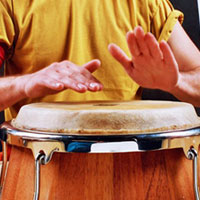Remembering rhythm patterns, use any tool you can find.
Once I do actually learn a rhythm, pattern or phrase it is usually because or helped by the fact that I hear it and sing it to myself as a simple melody. Melodies are interesting because they contain rhythm as well as musical notes. Interestingly enough melodies also spark or trigger emotions. Hopefully they are good ones!
Often when i remember a rhythm composition or drum pattern as a melody it is like a jingle or very short song. I notice myself singing it. I always tell students “if you can say it you can play it” and of course that rings true for me in my own learning process as well. Vocalizing enables us to “wire in” patterns in yet another positive way to our systems.
Of course that melody needs to sit in the right place in time as well. So I make sure it is in the right place with the down beat, with the pulse. When i have the chance I will write out the rhythm with a simple notation system on graph paper as well.
Many people are hesitant or think that writing out rhythms is complicated but it is something that can be learned quickly and easily. Notation system or tablature is not intended to be used to learn the feels of rhythms but instead is used most effectively to reference the rhythm or even demystify rhythm parts.
Again we do need to be careful as notation excludes feel which is elusive on paper and is something that in my opinion needs to be directly experienced live in context. However for helping to remember and understand drumming music notation is a fantastic tool.
Sometimes i learn by saying or singing the rhythm or part i am trying to learn consciously and often it just happens and then I say, “wow that’s cool”! For west african arrangements the dunun parts really remind me of bass lines. I find myself singing or humming the parts later in the day as well.
And of course congas have melodies of their own as well. Since they are more melodic then Djembes for example the conga patterns really lend them selves toward melodic interpretation. Djembe rely on the dunun and dunun arrangements to provide the melody for their arrangements.
One point I would like to make is that hearing the rhythm,parts and phrases as melodies or “jingles” is a choice you can make in your brain. When you listening back to a recording or watching a video or playing along to any of these simply choose to hear the melody rather then try and figure out the beat or question where notes lay.
By doing this you can effectively switch the side of the brain you are using and it helps you access the rhythms in a different and fun way as well.
Don’t be afraid to use your voice and say the part or sing the part you are learning. It really helps. I often notice people are very hesitant in my classes when asked to speak or say the part. Once you get over the fear and into the practice you will find it quite rewarding especially if you are a person that does not like numbers or math.
Of course we all have different ways we learn. Another tactic I use in drum classes I am attending is to learn whatever is being taught, one stroke at a time. That is to say beat by beat one note at a time starting with the first and adding notes consecutively in order.
Often it is overwhelming when we first here a long phrase or sequence we are going to learn in the class. The key is to just get the first beat, let the teacher cycle what they are going to teach and then get the first beat again and add the second beat and on and on, rather then trying to play the whole phrase right off the bat.
Furthermore, when you get home and are deciphering the rhythm I find almost anything can be learned and written out if you start and go at it with this approach, one beat at a time you just have to find the pulse. Where the notes hit in relation to the downbeat. In west african drumming using djembes and dununs you can almost always find it from the lead in call or break which always leads into “the one” or first beat of anything played.
This works for me almost every time. Please remember this is a process that happens over time, we all learn and remember in different ways. And, “if you can say it you can play it”. Learning to play the drums does not have to be a chore and it can indeed be easy or at least easier, if you follow these easy learning techniques.

